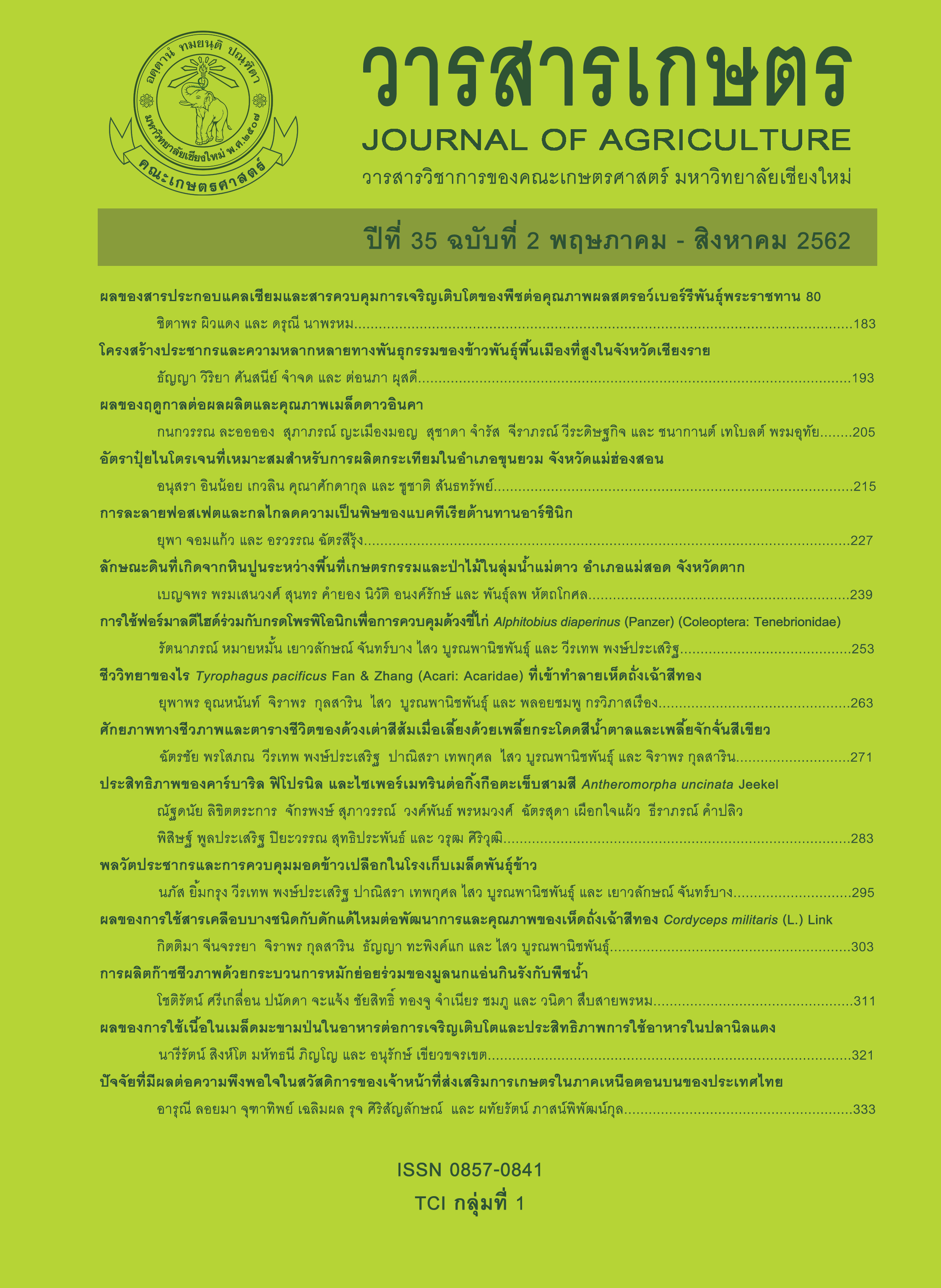Efficacy of Carbaryl, Fipronil and Cypermethrin Against Flat-back Millipede, <I>Antheromorpha uncinata</I> Jeekel
Main Article Content
Abstract
Over the last decades, some millipede outbreak is periodically occurred resulting in making trouble to people occupying in the areas. Use of chemicals for their control is an alternative choice to reduce this problem. The aim of current research was to study the effects of carbaryl, fipronil and cypermethrin on Antheromorpha uncinata Jeekel, 1968, in San Klang subdistrict, Phan district, Chiang Rai province. Millipede samples were treated with various insecticide concentration by direct spray. The percentage mortality was evaluated after 1, 12, 24 and 48 hours of exposure. Fipronil showed the highest LC50 value as 97.69 and 23.81 ppm at 1 and 24 hours, respectively. Cypermethrin has high LC50 value as 115.39 and 93.48 ppm at 1 hour while carbaryl has lowest LC50 value as 514.97 and 501.59 ppm at 24 hours, respectively. In addition, the highest mortality rates after exposure show correlated with the recommendation dose of all three synthetic chemical uses. Herein, carbaryl at the concentrations of 850 ppm was the most effective to control adult millipedes with 100% mortality after one hour of exposure. Moreover, fipronil at the concentration of 125 ppm at 12 hours after exposure yield 100% mortality. Meanwhile, cypermethrin at the concentration of 175 ppm held merely 83.33% mortality after exposure for 12 hours. The recovering evidence of millipedes after intake cypermethrin was also observed. Thus, use of carbaryl and fipronil are recommended as promised effective insecticide for controlling the emerging of millipede swarming.
Article Details
References
สมศักดิ์ ปัญหา. 2549. วิจัยกิ้งกือเรื่องไม่ยาก. โรงพิมพ์กรุงเทพ (1984) จำกัด, กรุงเทพฯ. 58 หน้า.
สิรีพัชร โกยโภไคสวรรค์ อัจฉริยา สุริยะวงศ์ สิทธิสุนทร สุโพธิณะ และ ภารดี ช่วยบำรุง. 2560. การสลายคาร์บาริลในน้ำด้วยปฏิกิริยาไทเทเนียมไดออกไซด์โฟโตคะตะไลสิส. วารสารวิทยาศาสตร์และเทคโนโลยี 25(6): 975-988.
สุนัยนา สท้านไตรภพ กสิน ศุภปฐม และ พรรณเกษม แผ่พร. 2553. ประสิทธิภาพทางชีววิเคราะห์ของผลิตภัณฑ์เคมีกำจัดแมลงคลานต่อแมลงสาบเยอรมัน (Blattella gernanica). วารสารวิชาการสาธารณสุข 19(6): 930-935.
Adama, I., K.O. Fening, M.B. Mochiah, M. Owusu-Akyaw and E. Andoh-Mensah. 2016. Knowledge of cassava pest management: The case of farmer training on integrated management of millipede infestation in outbreak areas in western region, Ghana. Asian Journal of Agricultural Extension, Economics & Sociology 14(4): 1-8.
Attems, C. 1931. Die Familie Leptodesmidae und andere Polydesmiden. Zoologica (Stuttgart) 79: 1-150.
Attems, C. 1936. Diplopoda of India. Memoirs of the Indian Museum 11(4): 133-323.
Attems, C. 1937. Myriapoda 3. Polydesmoidea I. Fam. Strongylosomidae. Das Tierreich 68: 1-300.
Bond, C., A. Hallman, K. Buhl and D. Stone. 2016. Carbaryl: General fact sheet. (Online). Available: http://npic.orst.edu/factsheets/carbarylgen. html (July 7, 2018).
Coombs, A.D., B.I. Carter, R.W. Hend, S.G. Butterworth and A.C. Buckwell. 1976. Toxicity studies on the insecticide WL-43467. Summary of results of preliminary experiments. Shell Research, Sittingbourne, Kent, England.
Cheng, S., J. Chen, Y. Qiu, X. Hong, Y. Xia, T. Feng, J. Liu, L. Song, Z. Zhang and X. Wang. 2006. Carbaryl inhibits basal and FSH-induced progesterone biosynthesis of primary human granulosa-lutein cells. Toxicology 220: 37-45.
de Lima Bicho, C. and G.A. Müller. 2017. Other irritating arthropods (beetles, bugs, centipedes, etc.). pp. 549-556. In: C. Marcondes (ed.). Arthropod Borne Diseases. Springer, Cham.
Ehrnsberger, R. 2002. Massenauftreten und Wanderung des Diplopoden Ommatoiulus sabulosus in Westniedersachsen. Osnabrücker Naturwissenschaftliche Mitteilungen 28: 199-203.
Golovatch, S.I. and R.D. Kime. 2009. Millipede (Diplopoda) distributions: A review. Soil Organisms 81(3): 565-597.
Gupta, R.C. and D. Milatovic. 2014. Insecticides. pp. 389-408. In: R.C. Gupta (ed.). Biomarkers in Toxicology. Elsevier, Amsterdam.
Jeekel, C.A.W. 1964. A new species of Orthomorpha Bollman from Thailand observed in migration, with taxonomic notes on the genus (Diplopoda). Tijdschrift voor Entomologie 107: 355-364.
Kavallieratos, N.G., C.G. Athanassiou, B.J. Vayias and P.C. Betsi. 2010. Insecticidal efficacy of fipronil against four stored-product insect pests: influence of commodity, dose, exposure interval, relative humidity and temperature. Pest Management Science 66: 640-649.
Lee, P. 2008. More swarming millipedes. (Online). Available: http://www.bmig.org.uk/sites/ www.bmig.org.uk/files/news/bmignews16. pdf (July 7, 2018).
Likhitrakarn, N., S.I. Golovatch and S. Panha. 2011. Revision of the Southeast Asian millipede genus Orthomorpha Bollman, 1893, with the proposal of a new genus (Diplopoda, Polydesmida, Paradoxosomatidae). ZooKeys 131: 1-161.
Likhitrakarn, N., S.I. Golovatch and S. Panha. 2014. Review of the Southeast Asian millipede genus Enghoffosoma Golovatch, 1993 (Diplopoda, Polydesmida, Paradoxosomatidae), with descriptions of new species. Zootaxa 3811(4): 491-514.
Likhitrakarn, N., S.I. Golovatch and S. Panha. 2016. Review of the Southeast Asian millipede genus Antheromorpha Jeekel, 1968 (Diplopoda, Polydesmida, Paradoxosomatidae). ZooKeys 571: 21-57.
Likhitrakarn, N., S.I. Golovatch and S. Panha. 2017. The first record of the pantropical millipede, Chondromorpha xanthotricha (Attems, 1898) (Diplopoda: Polydesmida: Paradoxosomatidae), from Thailand. Arthropoda Selecta 26(4): 281-287.
Likhitrakarn, N., S.I. Golovatch, I. Semenyuk and S. Panha. 2019. A new species and a new record of the Southeast Asian millipede genus Antheromorpha Jeekel, 1968 (Polydesmida: Paradoxosomatidae) from Vietnam. ZooKeys 832: 77-89.
Likhitrakarn, N., S.I. Golovatch, R. Prateepasen and S. Panha. 2010. Review of the genus Tylopus Jeekel, 1968, with descriptions of five new species from Thailand (Diplopoda, Polydesmida, Paradoxosomatidae). ZooKeys 72: 23-68.
Minelli, A. and S.I. Golovatch. 2001. Myriapods. pp. 291-303. In: S.A. Levin (ed.). Encyclopedia of Biodiversity, Vol. 4. Academic Press, San Diego.
Nagarjuna, A. and P. Jacob Doss. 2009. Acute oral toxicity and histopathological studies of cypermethrin in rats. Indian Journal of Animal Research 43(4): 235-240.
Niijima, K. 1998. Effects of outbreak of the train millipede Parafontaria laminata armigera Verhoeff (Diplopoda: Xystodesmidae) on litter decomposition in a natural beech forest in Central Japan. 1. Density and biomass of soil invertebrates. Ecological Research 13: 41-53.
Niijima, K. 2001. A millipede outbreak (Oxidus gracilis Koch) stopped trains. Edaphologia 68: 43-46.
Singh, A.K., M.N. Tiwari, O. Prakash and M.P. Singh. 2012. A current review of cypermethrin-induced neurotoxicity and nigrostriatal dopaminergic neurodegeneration. Current Neuropharmacology 10(1): 64-71.
Voigtländer, K. 2005. Mass occurrences and swarming behaviour of millipedes (Diplopoda: Julidae) in Eastern Germany. Peckiana 4: 181-187.
Wills, J.H., E. Jamieson and F. Coulston. 1968. Effects of oral doses of carbaryl on man. Clinical Toxicology 1: 265-271.


